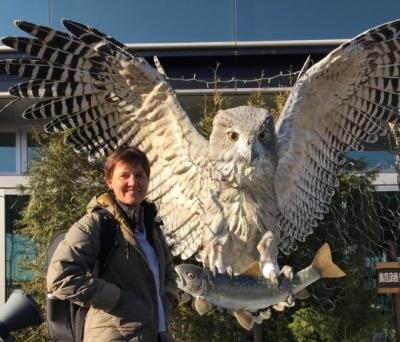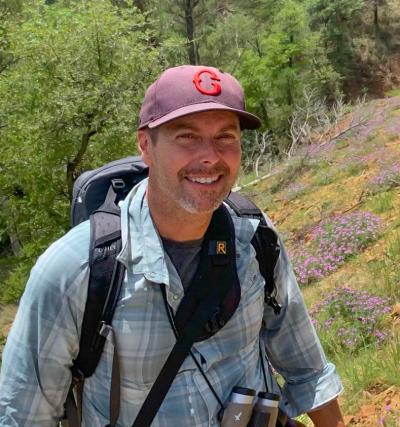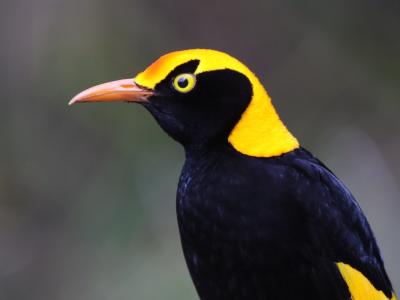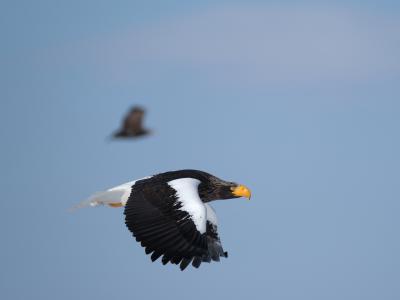Indonesia: The Moluccas
-
Oct 28 to Nov 18 2024
Susan Myers
The Moluccan islands of eastern Indonesia, known as Maluku in Indonesia, remain one of the world’s last great birding frontiers. This region encompasses innumerable small volcanic islands and coral reefs scattered through some of the deepest seas in the world. It lies at the crossroads of two continents, Asia and Australia, as well as two oceans, the Indian and the Pacific. As such, it has played a major role in our understanding of biogeography and evolution, thanks in large part to the groundbreaking work of Alfred Russel Wallace, one of the nineteenth century’s greatest intellectuals. His magnum opus, The Malay Archipelago, documents his experiences and thoughts during his time traveling the region.
On this special tour to a remote corner of the amazing Indonesian archipelago we’ll visit five islands: Ambon, Buru, Yamdena, Kai Kecil, and Seram. Using the small island of Ambon as a hub, we’ll travel by air and by ferry to the others. But we’ll have enough time on Ambon to find its one endemic, the Ambon White-eye, and we’ll also take time out to visit nearby Haruku Island to look for the elusive Moluccan Scrubfowl. Buru is the least visited of the islands on our itinerary, but it’s home to more than 20 endemics, and maybe more to come as several splits have been proposed. The tour then moves on to Yamdena, the main island of the endemic-rich Tanimbars. The island is ecologically different to the rest of the southern Moluccas, with a drier climate and much lower humidity. Much of the island is still actively being logged, but the endemic species can still be found in forest patches and degraded habitats close to the roads. Kai Kecil is the smaller of the two main islands of the Kai Archipelago but the easier of the two to access, and we’ll spend a couple of days here before moving on to Seram. Extensive forest still covers this long island, and the huge Manusela National Park lies along its mountainous spine. The majority of the island’s endemics can be found from the road that cuts through the park, and we’ll concentrate our efforts here. Bring your swimsuit—this tour offers opportunities for some of the best snorkeling in the world.
As is typical of Indonesia, each island is unique in its own way and so this tour promises excitement around every corner. The degree of endemism is astounding, and with at least 90 endemic birds, the Moluccas alone are considered a megadiverse region. The endemic bird fauna is dominated, but not restricted to five groups: pigeons, parrots, monarchs, honeyeaters, and white-eyes. But much remains unknown about the wildlife and wild places of these remote and exotic islands, and who knows what new discoveries we might make!
Day 1: The tour begins this evening in Jakarta. Night in Jakarta.
Susan’s leadership was outstanding considering the non homogeneous group (age, fitness, bird knowledge, and abilities to see and hear what we were seeking). I felt the challenge of arranging for so many different means of transport, places to stay and food was well planned, managed, and executed. The support staff were gracious and responsive to our needs sometimes recognizing difficulties for us and stepping up to help and knowing what to do without our even asking. They were habitually there when needed.Ted Aldrich, Nov 2017
Day 2: We’ll fly this morning from Jakarta to the small island of Ambon and then travel on to Buru by ferry. Ambon is the gateway to the islands of the Moluccas; it is relatively small but has the best infrastructure and is the center of business and administration. While we are on Ambon we’ll bird in a nearby forest for the island’s only endemic, the Ambon White-eye (timing for this may vary depending on ferry and flights schedules. Other possibilities here include a few endemics shared with the surrounding islands, such as Claret-breasted Fruit Dove, Ashy Flowerpecker, Moluccan Flycatcher, and Spectacled Monarch. Later we’ll take the overnight ferry from Ambon to Namlea on Buru Island. The ferry has private cabins with air conditioning.
Buru, one of the main islands of the Moluccas and the third largest after Halmahera and Seram, is about 81 miles from east to west and 56 miles from north to south. It’s nonvolcanic but mountainous, and Mount Kapalatmada, at about 8,000 feet, is the highest point. Primary forest still covers much of the island, especially in the highlands, but logging and land clearance for farmland has affected much of the lowlands. The attractive Danau (Lake) Rana is located in the center of the island at the cool altitude of 2,500 feet. Night on the ferry.
Day 3: We’ll pull into Namlea, Buru’s capital, early and drive about two hours along the north coast to our accommodation in Waspait, our home base during our exploration of the island. The accommodation is relatively comfortable by Buru standards and nicely located by the seaside. Brown Boobies, Lesser Frigatebirds, and Great Crested Terns are among the seabirds that can be seen along the shoreline outside our rooms. After lunch we’ll spend spend the afternoon getting our first endemics under our belts. We’ll search some nearby lowland forest for some our target birds, which include Black-tipped Monarch, Brown Cuckoo-Dove, Superb Fruit-Dove, Moluccan Cuckoo, Moustached Treeswift, Pale Cicadabird (a Moluccan endemic), White-naped Monarch, Slaty Flycatcher, Drab Whistler (endemic to the Moluccas and Sula), and the regional endemic Black-breasted Sunbird (a highly distinctive split from Olive-backed). Even widespread birds such as Golden-headed Cisticola, with its distinctive vocalizations, will be of interest, as many of these local races are potential splits. Night in Waspait.
Days 4–7: Very few birdwatchers have visited this lovely island, and around 20 endemics await us. During our explorations we’ll try to see as many of these as possible—birds such as Buru White-eye, Buru Drongo, Buru (or Black-faced) Friarbird, Buru Flowerpecker, Buru Golden Bulbul, Buru Green-Pigeon, Buru (or Spectacled) Imperial-Pigeon, Buru Mountain Pigeon, Wakolo Myzomela, and we have just a chance of seeing the rare endemic Blue-fronted Lorikeet, which had not been positively identified for many years, despite several surveys undertaken on Buru, until two birds were photographed in November 2014.
Using four-wheel drive vehicles, we’ll explore the very rough Wamlana logging road up to about 4,300 feet in elevation. Here we’ll search for Buru Cuckoo-shrike, Buru Bush-Warbler, Buru Leaf-Warbler, Tawny-backed Fantail, Buru Oriole, the more difficult Streak-breasted Jungle-Flycatcher (a regional endemic), the highly vocal Buru Racket-tail, Moluccan Red Lory (endemic to the southern Moluccas), and Red-breasted Pygmy-Parrot. We’ll also look for Buru Honeyeater and other more difficult targets such as Black-lored Parrot, the rare Buru Thrush, and Madanga (formerly known as Rufous-throated Dark-eye). We’ll mostly be birding at the relatively cool elevations above 4,000 feet.
During our stay on Buru we’ll also explore remnant forest patches on Bara, to the west of Waspait. Recent observations here include the scarce Buru Green-Pigeon as well as Lesser Masked-Owl, Hantu Boobook (split from Moluccan Boobook), the widespread Moluccan Scops-Owl, Forsten’s Scrubfowl, and Blue-breasted Pitta.
Along the shoreline we’ll look for waterbirds, waders and Palearctic migrants such as wintering groups of White-throated Needletails as well as the more expected Barn Swallow, Eastern Yellow Wagtail, Arctic Warbler, Gray’s Grasshopper-Warbler, and Grey-streaked Flycatcher. Nights in Waspait.
Day 8: After a last day of birding onBuru we’ll drive back to Namlea and take the overnight ferry back to Ambon. Night on the ferry.
Day 9: After our early morning arrival in Ambon we’ll transfer to the airport for a flight to Saumlaki on the island of Yamdena, one of the Tanimbar Islands. Night in Saumlaki.
Days 10–12: The Tanimbars are ecologically different from the rest of the southern Moluccas, with a drier climate and lower humidity. Nearly all of the Tanimbar endemics and regional endemic species can be seen on the main island of Yamdena, where we’ll spend the next three days. The island was originally covered in lowland and hill forest, but now of course logging and clearance has left a patchwork of farmland, plantations, secondary scrub, and remnant forest. During our birding on Yamdena we’ll concentrate on various roadside scrub patches along the main road out of Saumlaki. Many of the endemics are quite common, and our birding should be exciting, with endemics and specialties coming quick and fast. Tanimbar Corella, Blue-streaked Lory, White-browed Triller, and Tanimbar Starling should pose little problem, although some of the other endemics are not as common and require a little more effort. These include Tanimbar Boobook, Tanimbar Oriole, Long-tailed Fantail, Golden-bellied Flyrobin, Tanimbar Flycatcher, Slaty-backed Thrush, and Fawn-breasted Thrush, as well as White-tufted Honeyeater (a possible split from Scaly-breasted Honeyeater) and the near endemic Cinnamon-tailed Fantail. Loetoe Monarch and Tanimbar Bush-Warbler are more elusive denizens of the forest; the recently described bush-warbler is usually detected by its call and typically remains mostly hidden, giving just brief views as it dodges through the thick undergrowth. Nights in Saumlaki.
Day 13: Flying back to Ambon, we’ll connect with a flight to Tual on Kai Kecil. Night in Tual.
Day 14: We’ll explore Kai Kecil, a small island about 31 miles long and 12 miles wide, which is generally flat and very dry. The habitats here are dry forest and areas of scrub and grasslands. All the Kai Kecil endemics can be found relatively easily, and we’ll search forest patches for Kai Coucal, Kai Cuckoo-shrike, and Little Kai White-eye. Other species we’ll hope for include Yellow-capped Pygmy-Parrot, the endemic race of Southern Boobook, the endemic race of Island Leaf-Warbler (considered by many to be a split), Island Whistler, and Australian Figbird.
We’ll check out a coastal strip northeast of the village of Ohoililir, where we’ll bird a path that heads north through forest for about a mile and numerous side trails that head inland from this coastal track. Another trail will take us inland, climbing a ridge that then takes us through dry forest to search for Yellow-bellied White-eye, a small island specialist. Tanimbar Corella also occurs here, but its provenance is unknown. Southeast of Ohoililir another interesting track follows the coastline, starting at a large mudflat that may support numerous waders, depending on our timing. Further inland at an attractive freshwater lake we may find Little (“Tricolored”) Grebe, Spotted Whistling Duck, or Green Pygmy Goose, and the surrounding forest is rich in birds, including all the endemics of Kai Kecil. Night at the Kai Kecil Hotel.
Day 15: We’ll make an early start by speedboat to Kai Besar for our search for the Great Kai White-eye and “Kai” Leaf-Warbler. We’ll spend the day birding along a forest path where the leaf-warbler can be found at elevations above 1,300 feet. In the afternoon we’ll return to Kai Kecil. Night in Tual.
Day 16: After some early morning birding to look for any targets we may have missed, we’ll fly to Ambon in the afternoon. This evening we’ll take a speedboat to the nearby Haruku Island to search for the enigmatic Moluccan Scrubfowl. Night in Ambon.
Day 17: This morning we’ll take the fast ferry to Masohi, the main town on Seram. From Masohi we’ll drive three to four hours to Sawai, birding en route as we travel through the Manusela National Park. Night in Sawai.
Days 18–20: We’ll spend three days exploring the wonderful Manusela National Park and its surroundings on Seram. During our stay we’ll visit a range of altitudes and habitats, from patches of lowland forest to swamp forests along the north coast of the island and lovely (as well as cooler!) montane forests. A relatively new road now dissects Seram north to south, allowing us to more easily drive up to the magnificent forests at 4,300 feet, where we’ll search for high-altitude specialties. Seram is a large island with a rich avifauna, including a suite of attractive endemics and near-endemics. Some of the very special birds are the distinctive Seram race of Long-tailed (Seram) Mountain-Pigeon, Seram Imperial-Pigeon, Red Lory, Blue-eared Lory, the rare Purple-naped Lory, Seram Swiftlet, Seram Honeyeater, Seram Myzomela, Seram Friarbird, Pale-gray Cuckoo-shrike, Seram Golden Bulbul, Cinnamon-chested Flycatcher, Seram Thrush (very, very difficult), Streaky-breasted Fantail, Seram White-eye, Rufescent and Gray-hooded Dark-eyes, and Seram Oriole. Back down in the lowlands, Lazuli Kingfisher and Long-crested Myna can often be spied perched high on exposed branches. There is a good selection of raptors here too, such as Rufous-necked Sparrowhawk, Meyer’s Goshawk, Pygmy Eagle, and Gurney’s Eagle. One of our main targets will be the globally endangered and very lovely Salmon-crested or Seram Cockatoo. With luck we may also be able to find the remarkable Coconut Crab! Nights in Sawai.
Day 21: After some final birding on Seram we’ll return to Ambon on the afternoon ferry. Night in Ambon.
Day 22: In the afternoon we’ll fly back to Jakarta, where the tour concludes in time to connect with international flights home.
Note: The information presented here is an abbreviated version of our formal General Information for this tour. Its purpose is solely to give readers a sense of what might be involved if they take this tour. Although we do our best to make sure that what follows is completely accurate, it should not be used as a replacement for the formal document sent to all tour registrants, whose contents supersedes any information contained here.
ENTERING INDONESIA: United States citizens are required to have a passport valid for at least six months beyond your planned departure and with at least one blank page for a tourist stamp (two blank pages if coming from Bali). As of June 2015 passport holders from the US, UK and Canada (and 42 other countries) no longer need to complete the 30-day visitor visa upon arrival. You will still need to proceed through immigration and obtain a passport stamp which is good for 30 days. For those participants that are coming from non-exempt countries, visas can be obtained upon arrival and are valid for 30 days.
As soon as you book on the tour, please email the WINGS office a color scan of your passport – the page(s) with your photograph and passport details. These are needed by our ground agent to obtain permits to the various reserves we will visit during the tour.
COUNTRY INFORMATION: You can review the U.S. Department of State Country Specific Travel Information here: https://travel.state.gov/content/travel.html. Review foreign travel advice from the UK government here: https://www.gov.uk/foreign-travel-advice and travel advice and advisories from the Government of Canada here: https://travel.gc.ca/travelling/advisories.
PACE OF THE TOUR: Our birding days will normally begin quite early; as we are very close to the equator sunrise is around 6:00 a.m. and sunset is around 6.00 p.m. On most days we’ll bird in the morning until the midday heat of the day, with breaks after our lunches. Our leader will inform the group of trail conditions ahead of time so that anyone who wants to opt out has that opportunity. Most of the walking on this tour is fairly easy, on flat to undulating terrain with plenty of stops for birding. That said, please be aware that conditions do change and an easy pace cannot always be guaranteed. At this time of year temperatures are relatively low but it is nevertheless mostly hot and humid, although cooler in the hills and on the coast.
Most of our birding will be along the roadside. The vehicle will drop us in one spot and then we will walk along the road while scanning the forest for birds. We can call the vehicle at regular intervals if we need to move to other areas using two way radio communications. The only trek will be on Buru island for Rufous-throated White-eye. The vehicle drops us at about 1,000m above sea level where we will start our hike up to an elevation between 1,400-1,700m. There are some drives of three to four hours (may vary according to traffic and road conditions), and 4 ferry trips and 5 internal flights.
HEALTH: The Centers for Disease Control and Prevention (CDC) recommends that all travelers be up to date on routine vaccinations. These include measles-mumps-rubella (MMR) vaccine, diphtheria-tetanus-pertussis vaccine, varicella (chickenpox) vaccine, polio vaccine, and your yearly flu shot.
They further recommend that most travelers have protection against Hepatitis A and Typhoid.
Malaria: The CDC recommends a malaria prophylaxis. Note that Chloroquine resistant malaria is found in the region.
Please contact your doctor well in advance of your tour’s departure as some medications must be initiated weeks before the period of possible exposure.
The most current information about travelers’ health recommendations can be found on the CDC’s Travel Health website at http://wwwnc.cdc.gov/travel/destinations/traveler/none/indonesia .
Water: Tap water is not potable unless advised otherwise. Bottled water will be provided throughout the tour.
Insects: Mosquitoes can be present in the forests at this time of year so long sleeves and pants are recommended. At some sites chiggers can be a problem depending on climatic conditions. Leeches are generally not a problem in this part of the world but cannot be completely discounted.
Elevation: Nearly all of our birding will be at lower altitudes. The only place where we will bird at altitude is at Manusela on Seram and Mount Kapalatmada on Buru at about 3,000 m (8,000 ft) at the highest point.
Smoking: Smoking is prohibited in the vehicles or when the group is gathered for meals, checklists, etc. If you are sharing a room with a nonsmoker, please do not smoke in the room. If you smoke in the field, do so well away and downwind from the group. If any location where the group is gathered has a stricter policy than the WINGS policy, that stricter policy will prevail.
CLIMATE: The Moluccas have a typical equatorial climate with two seasons: wet and dry. The dry season reliably falls between April and October. Mean temperatures at sea level are uniform, varying by only a few degrees throughout the region and the year 78°- 82°F (25°- 28°C). However, temperatures decrease 2°F (1°C) for every 656 feet (200m) of altitude, which provides a cool, pleasant climate in upland communities. Even during the dry season humidity can be quite high at certain sites. Strong cyclones and typhoons, which normally occur in higher latitudes, are absent in Indonesia, but afternoon thunderstorms are relatively common.
ACCOMMODATIONS: Our accommodations consist of both Western-style hotels as well as more simple Indonesian style lodging. Where necessary, there will be mosquito netting. Bathrooms in the standard hotels will be that with which you are familiar, and have an en suite shower and toilet. The bathrooms in the Indonesian style lodges will be much simpler and oftentimes shared. Bathing in the Indonesian style lodges is sometimes referred to as “mandi,” which involves using a small container to scoop water out of a large container and pour water over the body in such a way that this water does not go back into the large container. While bathrooms here are shared, privacy will be guaranteed when in use.
The most basic of our accommodations will be on Seram (4 nights). Showers are provided (no hot water) along with a western toilet with manual flush (bucket of water). The hotel is built on stilts about 20-30 meters out from the shore.
WiFi, Internet and Cell Phones: Wifi is generally available in the hotels in larger towns, is free, but it is not necessarily reliable. Most require a password, which we’ll receive on check-in.
Cell phones can be useful while on tour but keep in mind that many countries operate on a different cellular technology than US or Canadian carriers.
FOOD: The food in Indonesia is varied and generally delicious. Vegetarian options are somewhat limited but by no means out of the question. Vegetarianism is a very unfamiliar concept in this part of the world and most meals are served with meat such as beef or, more often, chicken; pork is not usually available. Fresh seafood is a specialty in this huge archipelago. We will enjoy a mix of Indonesian and western style meals throughout.
Indonesian meals are commonly eaten with the combination of a spoon in the right hand and fork in the left hand (to push the food onto the spoon). Black tea is not readily available so if you prefer this to coffee or green tea, it may be worth bringing your own teabags. The food in this part of the world has a reputation for being spicy but in Indonesian cuisine, chili or “sambal” (similar in some ways to salsa) is usually added to the meal at the table and is thus optional. WINGS tours are all-inclusive and, no refunds can be issued for any missed tour meals.
Food Allergies / Requirements: We cannot guarantee that all food allergies can be accommodated at every destination. Participants with significant food allergies or special dietary requirements should bring appropriate foods with them for those times when their needs cannot be met. Announced meal times are always approximate depending on how the day unfolds.
TRANSPORTATION: We will be traveling in two or three 4WD vehicles throughout. Seating in the vehicle will rotate, and participants should be able to ride in any seat in tour vehicles. There are as well five internal flights on major internal airlines as well as 4 ferry trips between islands.
Susan’s leadership was outstanding considering the non homogeneous group (age, fitness, bird knowledge, and abilities to see and hear what we were seeking). I felt the challenge of arranging for so many different means of transport, places to stay and food was well planned, managed, and executed. The support staff were gracious and responsive to our needs sometimes recognizing difficulties for us and stepping up to help and knowing what to do without our even asking.
- Ted A. on Indonesia: The Moluccas
Maximum group size eight with one WINGS leader.

























































































